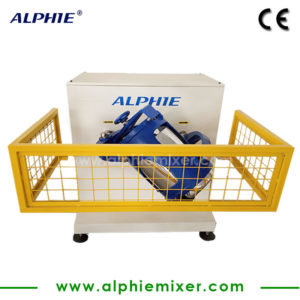Homogeneous and safe mixing of highly potent active pharmaceutical ingredients
For drug manufacturers, patient safety is of the utmost concern and efforts to prevent cross-contamination of highly potent active pharmaceutical ingredients (hpapi) are a crucial part of a safe manufacturing process. Likewise, the safety of workers who make apis or finished drug products, and the environment in which they work, is also paramount, particularly when manufacturing using compounds that require high containment. Inadequate containment of these compounds can put patients, employees, and the environment at increased risk, while decreasing product yields. Manufacturing costs can also rise with additional requirements for personal protective equipment and medical surveillance for workers, or for pollution controls and special housekeeping for manufacturing areas.

To ensure that employee exposure is kept within acceptable limits and to protect the environment while also containing costs, pharmaceutical companies and their contract partners who manufacture and handle high-containment compounds must wisely choose equipment such as the Alphie 3d mixer, also outline processes and procedures and deploy appropriate containment technologies.
Equipment and technology selection
Once the exposure potential is identified and a containment strategy selected, the equipment and technologies used to manufacture the hpapi must be selected. Factors to consider include the materials or compounds involved, the processes being used, environmental and safety considerations, and gmp requirements. A risk-based approach should be applied when selecting the type of containment strategy to use for a particular process. In general, the approach should consider the exposure limit, percent active, quantity, task duration, and material properties such as dust potential.
Homogeneous & safe mixing
A number of performance characteristics have to be considered carefully before making a choice of a solid-solid mixing device. Since a wide variety of equipment is available for mixing varieties of materials, the proper type of mixer should be chosen to give the desired degree of homogeneity for mixing the materials on hand. Too long a mixing may not result in a proper blend. A quantitative relationship between degrees of mixing vs. time is worth determining. Except in a few cases, if proper equipment is chosen, mixing should be over within 15 minutes. Some other aspects to be considered are the charging and discharging of the materials, power required for mixing, ease, frequency and thoroughness of cleaning (particularly when different types of batches are to be mixed at different times in the same machine), agglomerate breakdown and attrition requirements and dust formation (loss of dust particularly that of vital minor ingredients can seriously effect the composition of the mixture).
Investigations have shown the broad contribution of 3D mixing, which can mix powder and liquid in any proportion in a closed system simply and efficiently without the need of paddles, stirrers or turbines. In conventional mixers, the centrifugal force of the motion of rotation tends to favor segregation rather than mixing. There, the turbulence created (by baffles, inclined surfaces, etc.) is an afterthought and not intrinsic to the design of the blender.
To have the best possible homogeneity without compromising employee safety you should consider Alphie 3D powder mixer. Alphie has proven track record of mixing compounds even if they have different density or size. Alphie 3D mixer is recommended in highly unequal concentrations and kills the problem of lump formation when adding liquid to the powders.


Leave a Reply